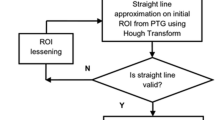Abstract
Mammography is a primary imaging method for breast cancer diagnosis. It is an important issue to accurately identify and separate pectoral muscles (PM) from breast tissues. Hough-transform-based methods are commonly adopted for PM detection. But their performances are susceptible when PM edges cannot be depicted by straight lines. In this study, we present a new pectoral muscle identification algorithm which utilizes statistical features of pixel responses. First, the Anderson–Darling goodness-of-fit test is used to extract a feature image by assuming non-Gaussianity for PM boundaries. Second, a global weighting scheme based on the location of PM was applied onto the feature image to suppress non-PM regions. From the weighted image, a preliminary set of pectoral muscles boundary components is detected via row-wise peak detection. An iterative procedure based on the edge continuity and orientation is used to determine the final PM boundary. Our results on a public mammogram database were assessed using four performance metrics: the false positive rate, the false negative rate, the Hausdorff distance, and the average distance. Compared to previous studies, our method demonstrates the state-of-art performance in terms of four measures.







Similar content being viewed by others
References
Tang J, Rangayyan RM, Xu J, Naqa IE, Yang Y: Computer-aided detection and diagnosis of breast cancer with mammography: recent advances. IEEE Trans Inf Technol Biomed 13:236–251, 2009
Zhou C, et al: Computerized image analysis: texture-field orientation method for pectoral muscle identification on MLO-view mammograms. Med Phys 37:2289–2299, 2010
Liu L, Wang J, He K: Breast density classification using histogram moments of multiple resolution mammograms. In: 3rd International Conference on Biomedical Engineering and Informatics (BMEI), 2010, pp 146–149
Moayedi F, Azimifar Z, Boostani R, Katebi S: Contourlet-based mammography mass classification using the SVM family. Comput Biol Med 40:373–383, 2010
Ganesan K, Acharya UR, Chua KC, Min LC, Abraham KT: Pectoral muscle segmentation: a review. Comput Methods Prog Biomed 110:48–57, 2013
Chakraborty J, Mukhopadhyay S, Singla V, Khandelwal N, Bhattacharyya P: Automatic detection of pectoral muscle using average gradient and shape based feature. J Digit Imaging 25:387–399, 2012
Karssemeijer N: Automated classification of parenchymal patterns in mammograms. Phys Med Biol 43:365–389, 1998
Kinoshita S, Azevedo-Marques P, Pereira Jr, R, Rodrigues J, Rangayyan R: Radon-domain detection of the nipple and the pectoral muscle in mammograms. J Digit Imaging 21:37–49, 2008
Yam M, et al: Three-dimensional reconstruction of microcalcification clusters from two mammographic views. IEEE Trans Med Imaging 20:479–489, 2001
Kwok SM, Chandrasekhar R, Attikiouzel Y, Rickard MT: Automatic pectoral muscle segmentation on mediolateral oblique view mammograms. IEEE Trans Med Imaging 23:1129–1140, 2004
Ferrari R, Rangayyan R, Desautels J, Borges R, Frere A: Automatic identification of the pectoral muscle in mammograms. IEEE Trans Med Imaging 23:232–245, 2004
Ma F, Bajger M, Slavotinek JP, Bottema MJ: Two graph theory based methods for identifying the pectoral muscle in mammograms. Pattern Recogn 40:2592–2602, 2007
Camilus KS, Govindan V, Sathidevi P: Computer-aided identification of the pectoral muscle in digitized mammograms. J Digit Imaging 23:562–580, 2010
Mustra M, Bozek J, Grgic M: Breast border extraction and pectoral muscle detection using wavelet decomposition. In: EUROCON 2009, 2009, pp 1426–1433
de Carvalho IM, et al: An automatic method for delineating the pectoral muscle in mammograms. In: IV Latin American Congress on Biomedical Engineering, Bioengineering Solutions for Latin America, Health, 2007, pp 271–275
Iglesias JE, Karssemeijer N: Robust initial detection of landmarks in film-screen mammograms using multiple FFDM atlases. IEEE Trans Med Imaging 28:1815–1824, 2009
Lehmann EEL, Romano JP: Testing statistical hypotheses, 3rd edition. Springer, New York, 2005
Suckling J et al: The mammographic image analysis society digital mammogram database. In: 2nd international workshop on digital mammography, 1994
Huttenlocher DP, Klanderman GA, Rucklidge WJ: Comparing images using the Hausdorff distance. Pattern Anal Mach Int IEEE Trans 15:850–863, 1993
Author information
Authors and Affiliations
Corresponding author
Rights and permissions
About this article
Cite this article
Liu, L., Liu, Q. & Lu, W. Pectoral Muscle Detection in Mammograms Using Local Statistical Features. J Digit Imaging 27, 633–641 (2014). https://doi.org/10.1007/s10278-014-9676-1
Published:
Issue Date:
DOI: https://doi.org/10.1007/s10278-014-9676-1




